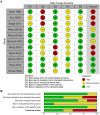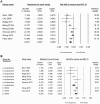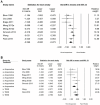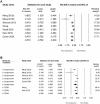Efficacy of Acupuncture in Managing Radiation-Induced Xerostomia: An Updated Meta-Analysis
- PMID: 40520905
- PMCID: PMC12163620
- DOI: 10.7150/ijms.110366
Efficacy of Acupuncture in Managing Radiation-Induced Xerostomia: An Updated Meta-Analysis
Abstract
Background: Xerostomia, or dry mouth, frequently affects head and neck cancer patients receiving radiotherapy, leading to discomfort and impacting daily functions such as speaking and swallowing. Conventional treatments may offer limited relief and are often accompanied by undesirable side effects. Acupuncture, as a non-pharmacological intervention, is increasingly explored for its potential to mitigate xerostomia symptoms. Objective: This systematic review and meta-analysis aim to assess the effectiveness of acupuncture in improving symptoms and quality of life in patients experiencing radiation-induced xerostomia. Methods: A thorough literature search was conducted across several databases, including MEDLINE, Embase, Cochrane Central, and Web of Science, up to the current year. We included randomized controlled trials (RCTs) that evaluated acupuncture's impact on salivary flow and symptom relief in adults with radiation-induced xerostomia. Primary outcomes were changes in salivary flow, with secondary outcomes including patient-reported symptom severity and quality of life metrics. The risk of bias was evaluated, and data were synthesized using a random-effects model. Results: A total of 11 RCTs involving 1271 participants were included in the analysis. The pooled data showed a moderate increase in salivary flow in the acupuncture group, effective in both resting and stimulated conditions. Additionally, acupuncture demonstrated significant benefits in reducing xerostomia symptoms and improving quality of life scores compared to control interventions. Subgroup analysis revealed that traditional acupuncture was more effective than Transcutaneous Electrical Nerve Stimulation (TENS). Conclusions: The findings suggest that acupuncture may be an effective complementary treatment for radiation-induced xerostomia, offering relief from dry mouth symptoms and potentially improving quality of life. Further research should focus on standardizing acupuncture protocols to confirm these benefits across diverse patient populations.
Keywords: cancer; dry mouth; quality of life.; salivary flow; systematic reviews.
© The author(s).
Conflict of interest statement
Competing Interests: The authors have declared that no competing interest exists.
Figures







Similar articles
-
Pharmacological interventions for preventing dry mouth and salivary gland dysfunction following radiotherapy.Cochrane Database Syst Rev. 2017 Jul 31;7(7):CD012744. doi: 10.1002/14651858.CD012744. Cochrane Database Syst Rev. 2017. PMID: 28759701 Free PMC article.
-
Systemic pharmacological treatments for chronic plaque psoriasis: a network meta-analysis.Cochrane Database Syst Rev. 2021 Apr 19;4(4):CD011535. doi: 10.1002/14651858.CD011535.pub4. Cochrane Database Syst Rev. 2021. Update in: Cochrane Database Syst Rev. 2022 May 23;5:CD011535. doi: 10.1002/14651858.CD011535.pub5. PMID: 33871055 Free PMC article. Updated.
-
Transcutaneous electrical nerve stimulation and acupuncture for primary dysmenorrhoea.Cochrane Database Syst Rev. 2002;2002(1):CD002123. doi: 10.1002/14651858.CD002123. Cochrane Database Syst Rev. 2002. PMID: 11869624 Free PMC article.
-
The preventive and therapeutic effect of acupuncture for radiation-induced xerostomia in patients with head and neck cancer: a systematic review.Integr Cancer Ther. 2013 May;12(3):197-205. doi: 10.1177/1534735412451321. Epub 2012 Jul 12. Integr Cancer Ther. 2013. PMID: 22791311
-
Clinical effectiveness and safety of acupuncture in the treatment of irradiation-induced xerostomia in patients with head and neck cancer: a systematic review.Acupunct Med. 2010 Dec;28(4):191-9. doi: 10.1136/aim.2010.002733. Epub 2010 Nov 9. Acupunct Med. 2010. PMID: 21062848
References
-
- Heiskanen V, Zadik Y, Elad S. Photobiomodulation Therapy for Cancer Treatment-Related Salivary Gland Dysfunction: A Systematic Review. Photobiomodul Photomed Laser Surg. 2020;38:340–7. - PubMed
-
- Dreizen S, Brown LR, Handler S, Levy BM. Radiation-induced xerostomia in cancer patients. Effect on salivary and serum electrolytes. Cancer. 1976;38:273–8. - PubMed
-
- Chambers MS, Rosenthal DI, Weber RS. Radiation-induced xerostomia. Head Neck. 2007;29:58–63. - PubMed
Publication types
MeSH terms
LinkOut - more resources
Full Text Sources
Medical

